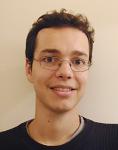EXC!TiNG Postdocs
Dr. Florent Tournus
 During my PhD, in Lyon (France), I have studied different cases of doping
in covalent cage-like nanostructured materials. I have studied
experimentally (by Raman spectroscopy, X-ray absoprtion and X-ray
diffraction) and theoretically (ab initio simulations in the density
functional theory formalism with the SIESTA code that uses a localized
basis set) some materials made of covalent cages: C60 and silicon
clathrates. Thus, my scientific background does not only concern ab initio
calculations and my postdoctoral position at the PCPM is a good opportunity
to have further training in this field.
During my PhD, in Lyon (France), I have studied different cases of doping
in covalent cage-like nanostructured materials. I have studied
experimentally (by Raman spectroscopy, X-ray absoprtion and X-ray
diffraction) and theoretically (ab initio simulations in the density
functional theory formalism with the SIESTA code that uses a localized
basis set) some materials made of covalent cages: C60 and silicon
clathrates. Thus, my scientific background does not only concern ab initio
calculations and my postdoctoral position at the PCPM is a good opportunity
to have further training in this field.
My work in the Exciting network, where I work with X. Gonze and Y.
Pouillon, is related to the milestone M6 (comparison of different
approaches), and also to the milestones M5, M2 and M1. More precisely, I
determine energy surfaces of ground state and excited states for the
dissociation of diatomic molecules, using the SCF method. This allows a
comparison with the results of the excitations obtained from time dependent
density functional theory (TD-DFT). This study is useful to get a better
understanding of the present results obtained for the ground state
dissociation of molecules calculated within the adiabatic connection
fluctuation-dissipation (ACFD) framework. This formalism should be able to
account correctly for van der Waals interactions, at all distances.
The calculations are performed with the ABINIT code, which uses a plane
wave basis set. This postdoctoral position is the occasion for me to get
more familiar with this formalism. I have also enhanced my knowledge of the
physics of excited electronic states and of the different actual methods
used in the calculations. It is a great opportunity to work in a European
network and I find that it is a very positive experience, from a human an
scientific point of view.
 During my PhD, in Lyon (France), I have studied different cases of doping
in covalent cage-like nanostructured materials. I have studied
experimentally (by Raman spectroscopy, X-ray absoprtion and X-ray
diffraction) and theoretically (ab initio simulations in the density
functional theory formalism with the SIESTA code that uses a localized
basis set) some materials made of covalent cages: C60 and silicon
clathrates. Thus, my scientific background does not only concern ab initio
calculations and my postdoctoral position at the PCPM is a good opportunity
to have further training in this field.
During my PhD, in Lyon (France), I have studied different cases of doping
in covalent cage-like nanostructured materials. I have studied
experimentally (by Raman spectroscopy, X-ray absoprtion and X-ray
diffraction) and theoretically (ab initio simulations in the density
functional theory formalism with the SIESTA code that uses a localized
basis set) some materials made of covalent cages: C60 and silicon
clathrates. Thus, my scientific background does not only concern ab initio
calculations and my postdoctoral position at the PCPM is a good opportunity
to have further training in this field.